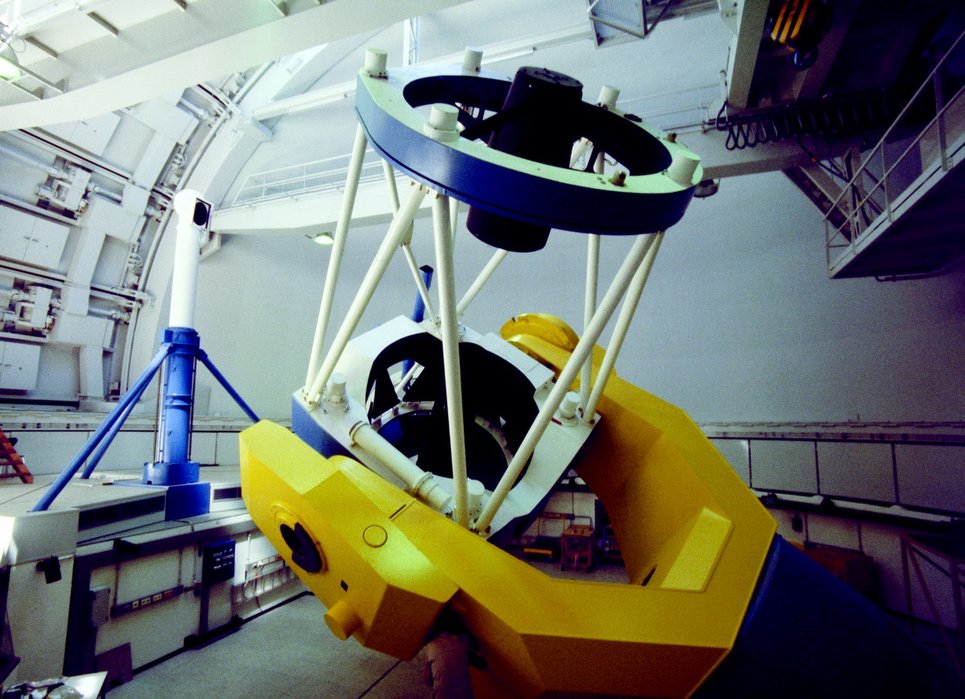Astronomers close in on planets that could be masters of survival
Two independent groups of astronomers, one led by Simona Ciceri of the Max Planck Institute for Astronomy, have discovered an unusually massive planet which orbits a red giant star. The planet, Kepler-432b, is one of a total of just five known planets which orbit red giant stars at a fairly close distance. Previously, it had been thought that such planets would be swallowed by their host stars fairly quickly; the new discovery indicates they might survive for longer than previously thought.

First hints of the existence of the planet Kepler-432b came from measurements of NASA’s Kepler space telescope. The telescope recorded tiny dips in the brightness of the planet’s host star, caused by the planet passing directly between the star and observers on Earth and blocking some of the star’s light (“planetary transit”). Such dips, however, can have causes other than orbiting planets. Confirmation that Kepler had indeed found a planet came only with the recent independent observations by two groups of astronomers: a group led by Simona Ciceri of the Max Planck Institute for Astronomy (MPIA) and one led by Mauricio Ortiz of the Centre for Astronomy of Heidelberg University (ZAH). The astronomers had used the CAFE spectrograph at the 2.2 meter telescope at Calar Alto Observatory to detect the planet’s traces in the spectrum of the star (“radial velocity method”). The group from ZAH also observed Kepler-432b with the Nordic Optical Telescope on La Palma (Canary Islands).
The combination of the observations by Kepler and with the CAFE spectrograph provided sufficient data to enable the astronomers reconstruct the planet’s size and mass. Kepler-432b turns out to be unusual in more than one respect. It is about the same size as Jupiter, but with six times Jupiter’s mass, making it unusually dense. Its orbit is an elongated ellipse, leading to temperature variations between 500 and 1000 degrees Celsius as the planet moves around its host star.
But the most puzzling aspect of Kepler-432b might be why it and other similar planets exist in the first place. The problem is the planet’s proximity to its host star. Of the nearly 1900 exoplanets known, around 50 orbit stars in the later stages of their lives: red giant stars, which have swollen to between ten and a hundred times their former size as their outer regions have heated up. For a star’s planets, this swelling-up can be fatal: Planets too close to the star will be swallowed up, and planets orbiting too close to the red giant’s surface are likely to be drawn in and swallowed within tens or a few hundreds of million years – a short time-span compared with the more than 10 billion years’ life-time of a star like our Sun.
Until now, astronomers have observed 5 planets, including Kepler-432b, which are unusually close to their red giant hosts. Of these, only two, namely Kepler-432b and Kepler-91b have been observed sufficiently closely to determine both their mass and their size (radial velocity and transit data). Another two have been detected only by measuring their planetary transits, while one has been found using spectral measurements only (radial velocity method).
If a phenomenon is fairly short-lived, astronomers do not expect to observe many examples of it. Simona Ciceri, the PhD student at the Max Planck Institute for Astronomy who led the first of the studies of Kepler-432b, says: “At this point, there are two possibilities: Either we have been unusually lucky to observe two rare, close planetary orbits such as those of Kepler-432b and Kepler-91b. Or else, planets like these survive for much longer than was previously assumed.” Now the data is in, it’s the turn of those who simulate planetary interaction with giant stars to re-check their simulations and to come up with an answer.
Even though the planet has proven a master of survival so far, in the long run, there will be no escape: “The days of Kepler-432b are numbered,” adds Mauricio Ortiz, the PhD student at Heidelberg University who led the other study of the planet. “In less than 200 million years, Kepler-432b will be swallowed by its continually expanding host star.”
Additional information
Press release by the University of Heidelberg
The work described here has been published by two independent groups as
S. Ciceri, J. Lillo-Box, J. Southworth, L. Mancini, T. Henning, D. Barrado: Kepler-432 b: a massive planet in a highly eccentric orbit transiting a red giant, Astronomy & Astrophysics 573 (January 2015), doi: 10.1051/0004-6361/201425145
M. Ortiz, D. Gandolfi, S. Reffert, A. Quirrenbach, H.J. Deeg, R. Karjalainen, P. Montañés-Rodríguez, D. Nespral, G. Nowak, Y. Osorio and E. Palle: Kepler-432 b: a massive warm Jupiter in a 52 day eccentric orbit transiting a giant star, Astronomy & Astrophysics 573 (January 2015), doi: 10.1051/0004-6361/201425146
